To read the full report, please download PDF.
USD demise on Fed credibility?
FX View:
The US dollar is closing out the week weaker as the fallout from the latest threat from President Trump to fire Fed Chair Powell lingers. We see this as more than just about whether Trump fires Powell. The comments from Fed Governor Waller indicate potential political influence with his comments much more explicit in calling for a July rate cut than in the past. Governor Bowman is also open to cutting in July. Is Trump’s influence already playing a role? That’s key given Trump likely has two more picks for Governors next year (to replace Kugler and Powell – we assume he will leave although technically he doesn’t have to). This week, the monthly TIC flow data for May was released – we dive into the details which show an unprecedented rebound in capital inflows after selling was recorded in April. Private foreign investor purchases of US assets was a record in May and over a 12mth period to May as well. There is no sign of “US exceptionalism” demise here. We argue hedging behaviour will be much more important and see that as the USD negative. We also look ahead to the ECB meeting next week which we assume will be broadly supportive for the EUR going into the quieter summer trading period.
USD REBOUND CURTAILED BY THREAT TO FED’S INDEPENDENCE
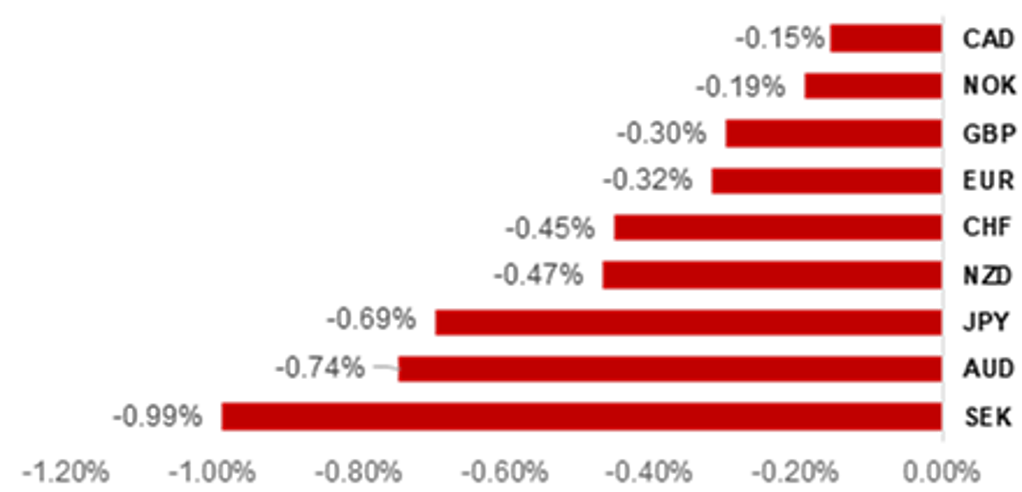
Source: Bloomberg, 15:15 BST, 18th July 2025 (Weekly % Change vs. USD)
Trade Ideas:
We are recommending a new long USD/JPY trade idea ahead of this weekend’s Upper House election, and maintain our long EUR/GBP trade idea.
JPY Flows:
This week we look at the monthly Balance of Payments statistics for May. Japan is now running a record current account surplus in JPY and GDP terms. In GDP terms it is now over 5%.
FX Correlation Heatmaps:
The correlations between G10 FX pairs and the price of gold have weakened over the past month. The weaker correlations could be a reflection that the loss of confidence in US policymaking and the USD has become less important in driving FX markets over the past month.
FX Views
USD: ‘US exceptionalism’ demise? Record inflows to US in May!
The renewed trade tariff focus since 7th July as President Trump released a series of letters highlighting tariff rates effective 1st August took a backseat toward the end of this week as the topic of the possible firing of Fed Chair Powell returned on Wednesday on reports that Trump had discussed the issue with a group of Republicans in Congress. There were quick denials and an initial 1.2% drop for the US dollar was fully reversed by yesterday afternoon. The episode this week was the second in which the markets moved abruptly on speculation of Fed Chair Powell being fired. The first was on 21st/22nd April when the dollar dropped by about 1.2% before recovering the following day when Trump denied he was planning to fire Powell. The April episode reinforced the theme of ‘US exceptionalism’ demise with speculation that investors would start to move away from US assets after years of strong buying.
This speculation was given some credence when the Treasury International Capital flow data for April, released in June, revealed selling of US portfolio securities in April. Foreign private investors sold USD 20.5bn of US securities in April while foreign official entities sold USD 30.1bn. US Treasury bond and equity sales were the primary assets sold. The total sale of USD 50.6bn was the largest since covid-related selling in 2020. Still, the selling was hardly indicative of a sharp deterioration in sentiment toward US assets especially when compared to the buying prior to the April selling. Yesterday, the TIC flow data for May was released and the data has completely put to rest the idea of investors fleeing the US because of a loss of confidence due to Trump’s approach to economic policy making. Foreign private investors bought a huge USD 288bn worth of US securities in May – USD 120bn worth of UST bonds; USD 32bn worth of agency bonds; USD 32bn of corporate bonds; and USD 104bn worth of equities. The UST bond buying was the fifth largest on record while the agency bonds and equity buying were the fourth largest on record. The USD 288bn total was by far a record total for foreign private investor buying
The selling of US assets has in general been more evident amongst foreign official entities but this was not the case in May with total securities purchases of USD 31bn mainly via purchases of UST bonds of USD 27bn. The bigger trend though is key here with foreign official entities clearly running down their securities holdings – mainly UST and agency bonds. But this year there has also been a pick-up in equity selling. In 2024 foreign official entities sold USD 8bn worth of securities with UST bond and agency bond sales being slightly larger than the buying of corporate bonds and equities. On a 12mth rolling sum basis to May 2025 foreign official entities sold USD 139bn of US securities.
TOTAL FOREIGN INVESTOR BUYING A RECORD IN MAY
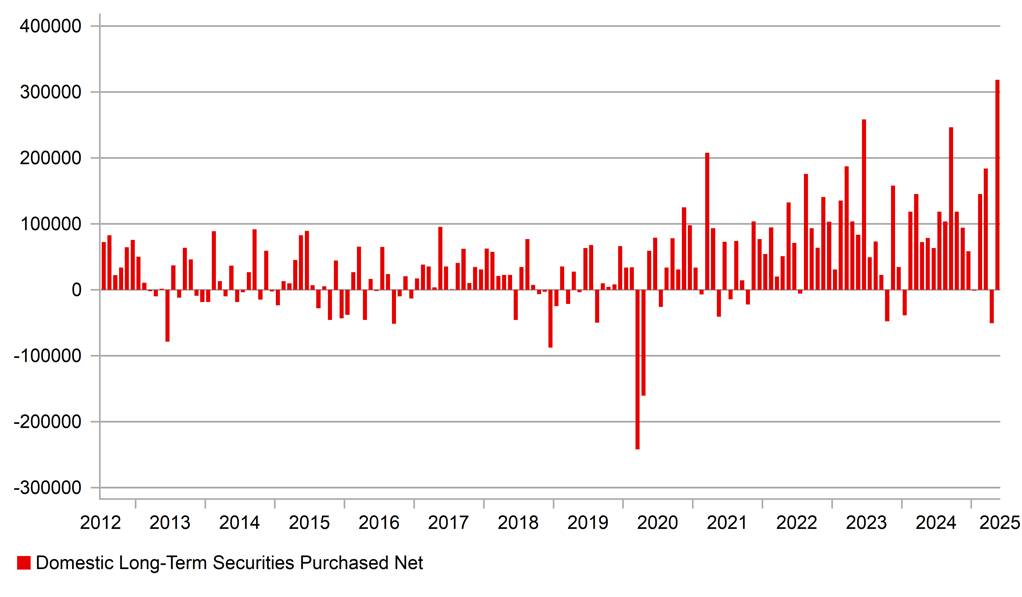
Source: Bloomberg, Macrobond & MUFG GMR
12MTH US INFLOWS AT A NEW RECORD HIGH IN MAY
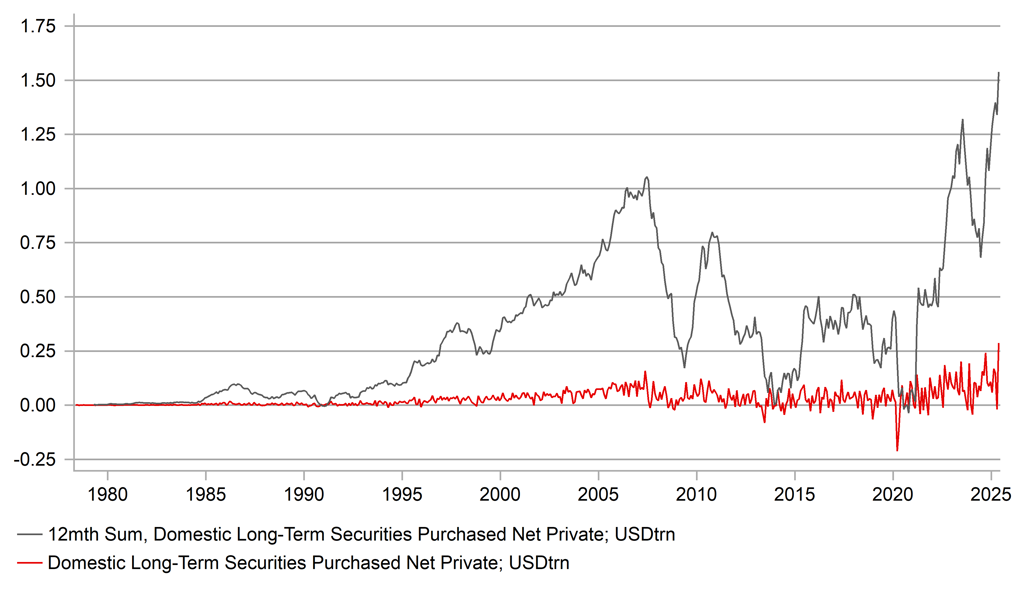
Source: Bloomberg, Macrobond & MUFG GMR
That 12mth selling by foreign official entities is insignificant when compared to the buying by private investors. Their purchases of US securities in the 12mths to May totalled USD 1,538bn, a new record high breaching the previous record set in March. Of course these record inflows in part reflect the blow-out in the US trade deficit which currently is running at a 12mth sum total of USD 1,382bn as of May. If Trump’s trade tariffs are successful in shrinking the record US trade deficit, then we will see the record capital inflow into US securities subside as well. Measuring a demise in investor confidence in US assets is perhaps more measured by the level of the US dollar and the rate of return foreign investors seek for holding those securities.
We have already highlighted the importance of gauging foreign investor confidence in US assets more from the potential increased appetite for hedging rather than a notable pick-up in capital flight. The US dollar reserve currency status is crucially linked to simply the sheer size of the US capital markets – there’s nowhere else to go. Sure, holdings could come down by a notable amount to significantly impact the value of the dollar but the global macro backdrop does not point to that being a realistic scenario – even with Trump’s unpredictable approach to economic policy. China rates are at record lows as policymakers fight deflation risks. Prospects in Europe do look better but is dependent on capital markets and services sector reforms that are in the early stages. The greater possibility is through increased hedging of current US security holdings. The 10% drop in USD/TWD in May was likely a reflection of underhedged US securities exposures. After the longest US dollar bull-run on record (2014-2024) and a Fed funds rate at pre-GFC levels, US dollar hedge ratios have drifted lower. Further Fed rate cuts will likely act to see increased dollar hedging by global investors. As of the end of last year, foreign investors held over USD 31trn worth of US bonds and equities – so small increases in hedge ratios would involve notable dollar selling.
Beyond the ‘will he, won’t he?’ fire Fed Chair Powell (still seems unlikely to us given it is complicated and may not achieve what Trump wants; ie: lower rates) the FOMC is set to undergo considerable change within the next year. Adriana Kugler’s term as Governor ends in January and Powell’s term as Chair ends in May (technically Powell could stay on as Governor but that’s very unlikely) which means four Governors will have been chosen by Trump (including Waller and Bowman). When you now have Waller and Bowman vocally calling for a rate cut in July, there are reasons for investors to worry and therefore price in higher inflation risks over the medium-term. That’s starting to happen – the 10-year breakeven is up 16bps month-to-date, which would be the biggest monthly gain since October 2022. A hit to confidence and renewed dollar selling is likely whether Trump fires Powell or not.
10YR BREAKEVEN CURRENTLY +16BPS IN JULY, THE BIGGEST INCREASE SINCE OCT 2022
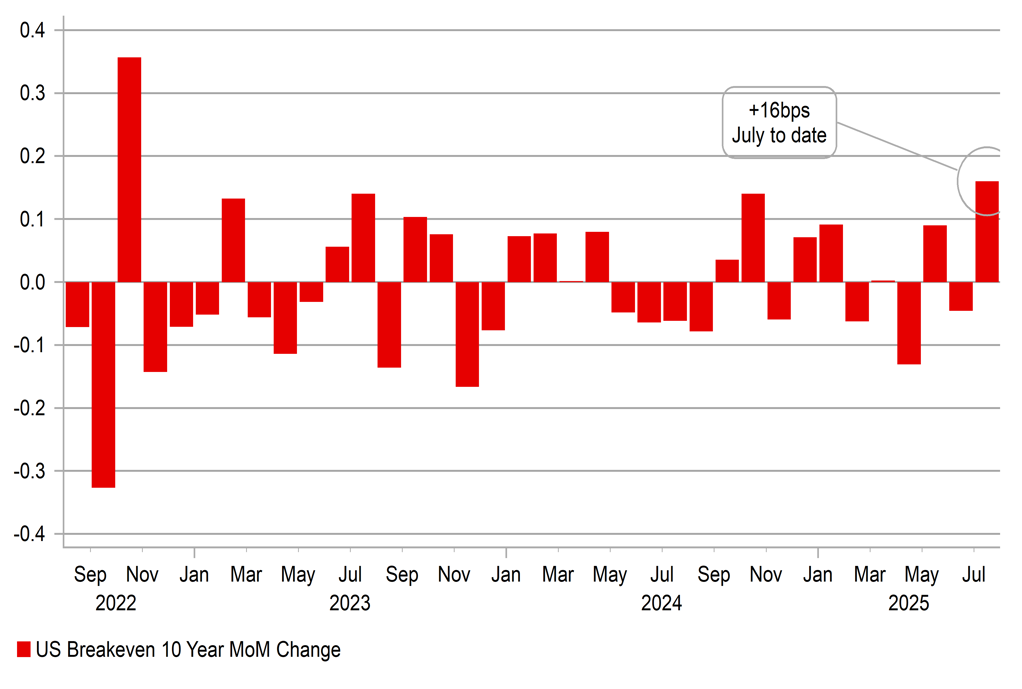
Source: Bloomberg & MUFG GMR
A STEEPER 2S10S YIELD CURVE SEEMS LIKELY ON FED INTERFERENCE WHICH POINTS TO WEAKER USD
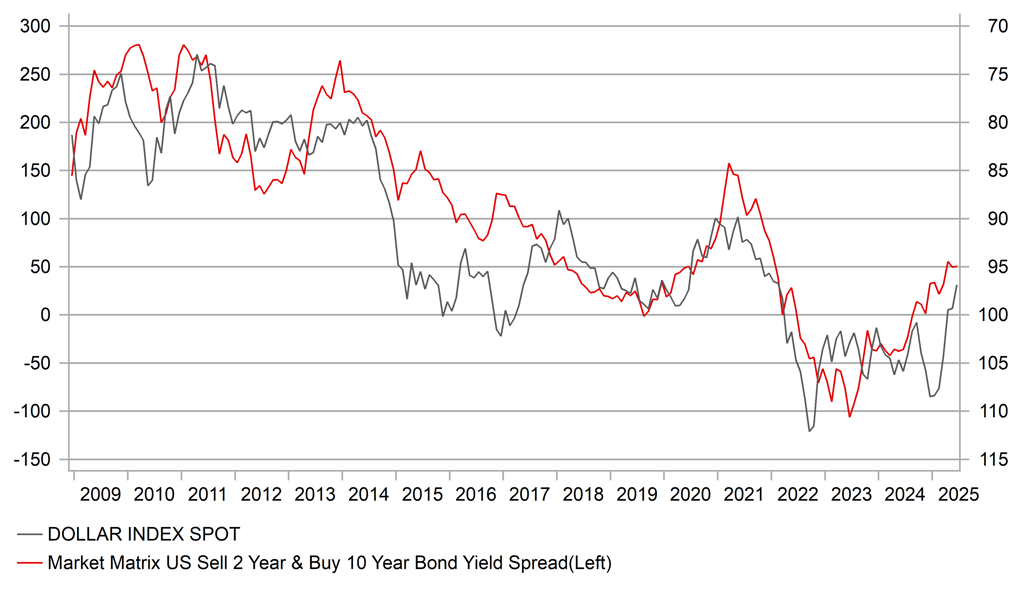
Source: Bloomberg, Macrobond & MUFG GMR
EUR: ECB to weigh up risks from stronger EUR but leave rates on hold
The EUR has lost some upward momentum after strong gains recorded between March and June. The ECB’s trade-weighted exchange rate (EEREE41) strengthened sharply by around 7.0% over that period. Over the last twenty years there have been only three other occasions when the trade-weighted EUR has increased by 7% or more over a four month period. The most recent period was between April 2017 and July 2017 and then further back between May 2015 and August 2015, and between December 2008 and March 2009. While past price action is not a reliable indicator of future price action, on all three occasions the trade-weighted EUR either consolidated at higher levels in the following four months and/or corrected modestly lower. It supports our view that the trade-weighted EUR is unlikely to continue strengthening as sharply as it has done at the start of this year.
The sharp strengthening of the EUR has drawn more concern from ECB policymakers (click here) over the past month. In the minutes from the last ECB policy meeting in June, policymakers noted that the “recent appreciation of the euro should weigh on exports” and that “downward pressure on inflation could be amplified if…the euro appreciates more strongly”. Comments from ECB policymakers on the euro reached a crescendo around the ECB’s Central Bank Forum held in Sintra between 30th June and 2nd July. Governing Council member Villeroy de Galhau stated that “the ECB is closely watching exchange rate volatility. Euro appreciation has a clear disinflationary effect”. ECB Vice President Luis de Guindos even mention specific levels for EUR/USD when he stated “I think 1.1700. even 1.2000, is not something. We can overlook it a bit. Something beyond that would be much more complicated…the pace of the euro’s appreciation is a bigger concern than where it is right now”. After trading at much lower levels in recent years EUR/USD has quickly moved back closer to the average level over the last thirty years of around 1.1850.
The impact of the stronger EUR for the economic outlook in the euro-zone is likely to be one important focus amongst market participants at next week’s ECB policy meeting. We are expecting the ECB to repeat the message from the June policy meeting that that the stronger EUR continues to pose downside risks to growth alongside higher tariffs via their negative impact on exports, while posing downside risks to the inflation outlook as well. In the Q&A following the last policy meeting in June, President Lagarde did not sound too concerned over EUR strength indicating that it was partly a reflection of increased investor confidence in the growth outlook in the euro-zone attracting more capital inflows, and not just as a result of a loss of confidence in the USD. We see no clear reason for the ECB to change that assessment even though the EUR has continued to strengthen further since the June meeting.
SHARPLY STRONGER EUR DRAWS MORE CONCERN
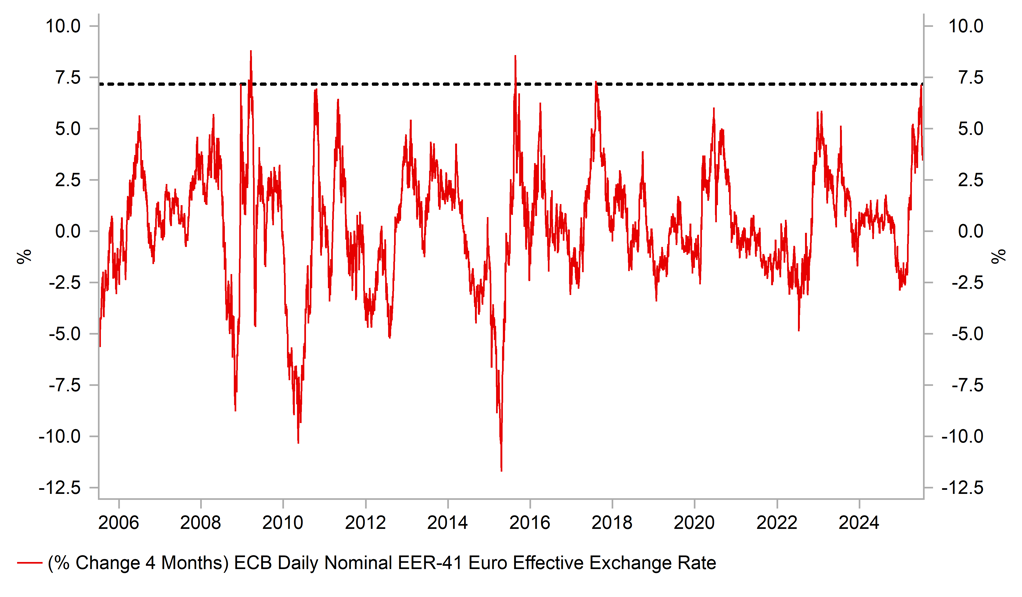
Source: Bloomberg, Macrobond & MUFG GMR
EUR PERFORMANCE AFTER SIMILAR STRONG GAINS
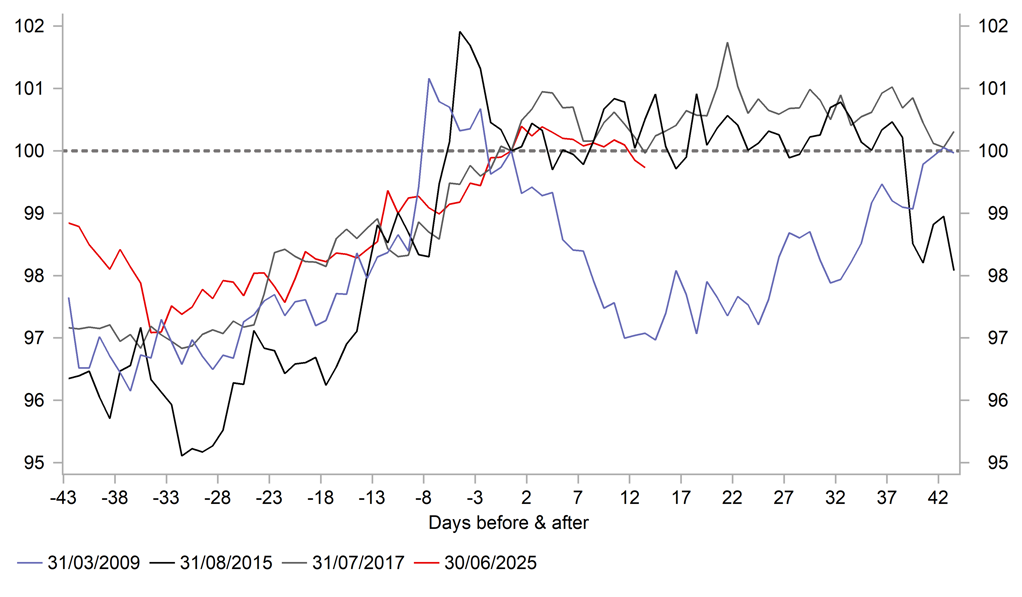
Source: Bloomberg, Macrobond & MUFG GMR
At best any comments from the ECB displaying more unease over the recent sharp strengthening of the EUR at next week’s policy meeting may have a dampening impact on the EUR’s upward momentum, but are unlikely to trigger a sustained reversal of the current strengthening trend. It is a view shared by market participants who have become less confident that the ECB will cut rates further this year despite the downside risks to inflation from the stronger EUR. There are currently only around 11bps of cuts priced in for the following ECB policy meeting in September and 23bps by year end. Even the threat from President Trump to raise tariffs to 30% on EU imports from 1st August has failed to trigger a dovish repricing of ECB rate cut expectations. Market participants remain optimistic that a trade deal will be reached in time to prevent the current 10% tariff rate being raised all the way up to 30%. If a deal is reached that keeps the current 10% tariff rate in place, we would scale back our forecast for two further 25bps ECB cuts this year. Whereas the implementation of a higher tariff rate of say 20-30% would leave the door more ajar for further rate cuts. At next week’s policy meeting, the ECB can only really continue to acknowledge the ongoing uncertainty related to US trade policy and downside risks posed to the economic outlook. As a result, the ECB is expected to leave rates on hold next week. Officials have indicated that there’s a higher hurdle for further cuts after the policy rate returned to neutral levels.
One other area of market attention over the past week has been the release of French Prime Minister Bayrou’s proposals for the 2026 Budget (click here). He has stuck to the target for next year’s budget deficit of 4.6% of GDP. To lower the budget deficit from this year’s target of 5.4%, the proposals have outlined measures to tighten fiscal policy totalling EUR43.8 billion. The stage is now set for another political showdown to pass the Budget in the autumn. The National Assembly will reconvene on 22nd September and the draft budget must be presented by the first week of October. The risk of renewed political instability in France may temporarily help to dampen EUR strength later this year.
Looking back at recent periods of heightened political risk in France, the biggest market impact has been evident in the French government bond market while negative spill-overs to the EUR have been more modest. For example in June 2024 prior to the last parliamentary elections in France, the yield spread between 10-year French and German government bond widened sharply by around 30bps to 0.78% but EUR/USD only briefly declined by -2.3% which was reversed in just over a month. The hurdle is higher to trigger a more sustained loss of confidence in the EUR with no major political parties proposing for France to leave the single currency. A more disruptive loss of confidence in France’s public finances that negatively impacts government bonds and growth in France is the main likely channel of contagion to the EUR.
EUR STRENGTH REFLECTING IMPROVED EURO-ZONE GROWTH OUTLOOK ARE LESS CONCERNING
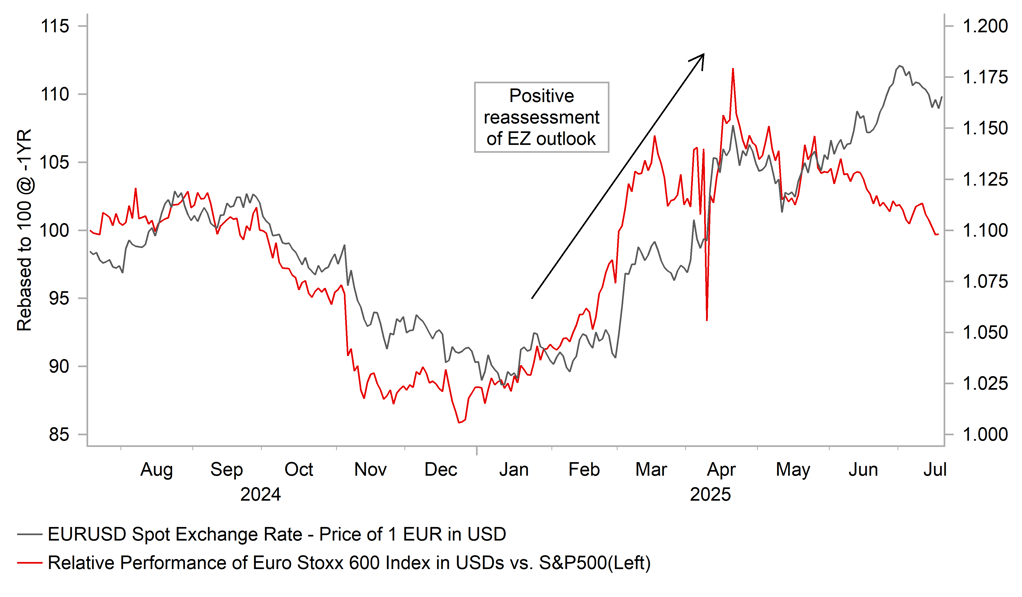
Source: Bloomberg, Macrobond & MUFG GMR
NEGATIVE SPILLOVERS FOR EUR FROM FRENCH POLITICAL RISK HAVE BEEN BRIEF & MODEST

Source: Bloomberg, Macrobond & MUFG GMR
Weekly Calendar
|
Ccy |
Date |
BST |
Indicator/Event |
Period |
Consensus |
Previous |
Mkt Moving |
|
JPY |
20/07/2025 |
12:00 |
Upper House election polls close |
!!! |
|||
|
NZD |
20/07/2025 |
23:45 |
CPI YoY |
2Q |
2.8% |
2.5% |
!!! |
|
USD |
21/07/2025 |
15:00 |
Leading Index |
Jun |
-0.2% |
-0.1% |
!! |
|
CAD |
21/07/2025 |
15:30 |
BoC Overall Business Outlook Survey |
2Q |
-- |
- 2.1 |
!! |
|
AUD |
22/07/2025 |
02:30 |
RBA Minutes of July Policy Meeting |
!! |
|||
|
GBP |
22/07/2025 |
07:00 |
Public Sector Net Borrowing |
Jun |
-- |
17.7b |
!! |
|
EUR |
22/07/2025 |
09:00 |
ECB Bank Lending Survey |
!! |
|||
|
USD |
23/07/2025 |
15:00 |
Existing Home Sales |
Jun |
4.00m |
4.03m |
!! |
|
AUD |
24/07/2025 |
00:00 |
S&P Global Australia PMI Composite |
Jul P |
-- |
51.6 |
!! |
|
JPY |
24/07/2025 |
01:30 |
S&P Global Japan PMI Composite |
Jul P |
-- |
51.5 |
!! |
|
AUD |
24/07/2025 |
04:05 |
RBA's Bullock-Speech |
!!! |
|||
|
EUR |
24/07/2025 |
07:00 |
Germany GfK Consumer Confidence |
Aug |
-- |
- 20.3 |
!! |
|
EUR |
24/07/2025 |
09:00 |
HCOB Eurozone Manufacturing PMI |
Jul P |
-- |
49.5 |
!!! |
|
EUR |
24/07/2025 |
09:00 |
HCOB Eurozone Services PMI |
Jul P |
-- |
50.5 |
!!! |
|
GBP |
24/07/2025 |
09:30 |
S&P Global UK Manufacturing PMI |
Jul P |
-- |
47.7 |
!!! |
|
GBP |
24/07/2025 |
09:30 |
S&P Global UK Services PMI |
Jul P |
-- |
52.8 |
!!! |
|
EUR |
24/07/2025 |
13:15 |
ECB Deposit Facility Rate |
24-Jul |
-- |
2.0% |
!!! |
|
CAD |
24/07/2025 |
13:30 |
Retail Sales MoM |
May |
-- |
0.3% |
!! |
|
USD |
24/07/2025 |
13:30 |
Initial Jobless Claims |
-- |
-- |
!! |
|
|
EUR |
24/07/2025 |
13:45 |
ECB President Lagarde Press Conference |
!!! |
|||
|
USD |
24/07/2025 |
14:45 |
S&P Global US Composite PMI |
Jul P |
-- |
52.9 |
!! |
|
USD |
24/07/2025 |
15:00 |
New Home Sales |
Jun |
650k |
623k |
!! |
|
JPY |
25/07/2025 |
00:30 |
Tokyo CPI YoY |
Jul |
3.0% |
3.1% |
!!! |
|
SEK |
25/07/2025 |
07:00 |
Unemployment Rate SA |
Jun |
-- |
9.0% |
!! |
|
GBP |
25/07/2025 |
07:00 |
Retail Sales Inc Auto Fuel MoM |
Jun |
-- |
-2.7% |
!!! |
|
EUR |
25/07/2025 |
09:00 |
Germany IFO Business Climate |
Jul |
-- |
88.4 |
!! |
|
EUR |
25/07/2025 |
09:00 |
ECB Survey of Professional Forecasters |
!! |
|||
|
USD |
25/07/2025 |
13:30 |
Durable Goods Orders |
Jun P |
-10.3% |
16.4% |
!! |
Source: Bloomberg & MUFG GMR
Key Events:
- The outcome from the Upper House elections in Japan will be the main focus for market participants at the start of next week. The election polls will close at 8.00PM Tokyo time. Major broadcasters are expected to begin exit polls and early projections in the first hour after the polls have closed. While it is a public holiday in Tokyo on Monday, the results of the election should still be known at the start of next week. The latest opinion polls have highlighted that the ruling coalition has lost momentum heading into the election and is at risk of losing their majority which requires winning 50 of the seats that are up for election. If the government falls short, it will cast doubt on the future of Prime Minister Ishiba and further compromise the government’s ability to implement their policy agenda without compromise.
- The ECB are expected to leave rates on hold leaving the policy rate at 2.00%. At the last policy meeting in early June, President Lagarde signaled that they have “just nearly concluded the policy cycle” implying that they are not planning much if any further easing. Recent comments from ECB officials have also indicated that there is a higher bar now for further rate cuts. Economic data since the last policy meeting has not provided a compelling reason to deliver back-to-back rate cuts this month. The stronger euro is attracting more concern amongst ECB policymakers and President Trump’s threat to raise tariffs on imports from the EU to 30% from 1st August should encourage the ECB to leave the door ajar for further cuts in the updated policy guidance. An EU-US trade deal over the summer would make it less likely that are forecasts for two further 25bps cuts this year will be realized.
- The main economic data releases in the week ahead will be: i) the latest PMI surveys from the euro-zone and UK for July, ii) New Zealand CPI report for Q2 and iii) UK retail sales report for June. The release over the past week of the latest UK CPI and labour market reports have supported expectations for the BoE to cut rates again in August but have dampened expectations for back-to back cuts in September as well.
